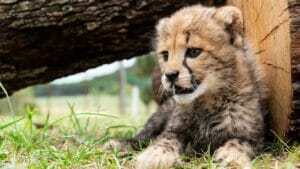
Appearance
Cheetahs are one of the world’s most recognizable big cats, due to their golden coats covered in dark spots. Their eyes are surrounded by a natural “eye-black” pattern, and their tail features a unique stripe pattern that can help researchers identify them. When young, cheetah coats are puffy and lightly colored, to help cubs hide from larger species in the tall grass.
Adaptations
The cheetah is built for speed and can accelerate from 0-45 mph in 2.5 seconds, reaching a top speed of 60-70 mph. This unmatched pace makes them the fastest land mammal on earth. Despite this, however, they can only run about 300 yards at peak speed.
Cheetahs' bodies are built to accommodate their speed. Their oversized nostrils, as well as increased lung capacity and extremely flexible spine help them sprint. Blunt, semi-retractable claws and special paw pads grip the ground like cleats for traction, and a long muscular tail acts as a rudder to counteract their body weight during a chase.
While most cats are nocturnal predators, cheetahs are primarily diurnal, hunting in the early morning and late afternoon. Since they depend on sight more heavily than smell, they like to scan the countryside from a kopje, or the top of a termite mound.
Despite all of these adaptations, only about half of chases for prey are successful. Without large teeth, cheetahs' fighting abilities are limited. Larger, stronger cats like lions easily overwhelm them, so cheetahs tend to opt for flight versus fight.
Conservation
Fossil Rim has played an important role in the conservation of cheetahs since 1986 when our first litter of cubs was born. Up until recently, breeding success has been particularly difficult in captive populations, which makes facilities like ours extremely important. Though breeding is still hard, scientific advancements have made huge strides when it comes to this complicated species.
Cheetahs have very low levels of genetic variation compared to other mammals, which has left them susceptible to disease. This genetic similarity may have developed due to a population reduction that occurred about 10,000 years ago. There are approximately 7,000 cheetahs in the wild. The global captive population is roughly 2,000.
Fossil Rim has diligently worked to provide a comfortable, stimulating living environment, multiple mate choices (especially important for cheetah females), a varied diet, large enclosures, and the least amount of stress possible.
Where are they?
As you travel through the fourth pasture you enter, you will go upwards onto a hill we appropriately call Cheetah Hill. Keep driving and you will arrive at the cheetah yards.
VIEWING TIPS
Like nearly all animals at Fossil Rim, the early morning is the best time to visit cheetahs. During the afternoon, they may be napping. If that is the case, keep a watchful eye out as you travel past the yards, as a still cheetah can be more difficult to spot (no pun intended.)
Quick Facts
Scientific Name | Acinonyx jubatus |
Species Survival Plan | Yes |
Habitat | Savannah and open woodlands |
Food | Wild - small antelope, the young of large antelope, warthog, hare and game birds |
Originally Native To | Africa, small remnant population in Iran |
Characteristics | Yellowish-gray coat with black spots; face marked with dark lines from corner of eyes to corner of mouth; long legs and very long white-tipped tail |
Gestation Period | 93 - 94 days |
Lifespan | Wild 7 - 9 years |
Social Behavior | Solitary animals; males are territorial and brothers form small, permanent groups; females tend to avoid each other |






